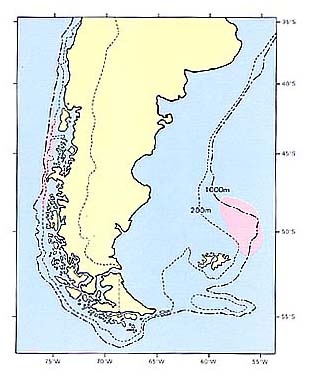オオメマトウダイ科
- HOME
- デジタル図鑑
- パタゴニア海域の重要水族
- 硬骨魚綱 マトウダイ目 オオメマトウダイ科
オオメマトウダイ科(Oreosomatidae)

58
ヒョウマトウダイ(Hiyoo-matoudai)
Pseudocyttus maculatus Gilchrist, 1906
Smooth Oreo (NZ.)
特 徴:
背鰭5~7棘,33~36軟条,臀鰭2~3棘,31~34軟条,胸鰭19~22軟条,腹鰭1棘,5軟条,鰓耙数4~7+16~19=20~25,鰓条骨数5~6。頭長は体長の32.5~38.5%,眼径は8.9~10.9%,体高は54.9~65.0%,吻長は7.7~10.0%,両眼間隔は10.6~12.4%,上顎長は12.9~15.7%,尾柄高は6.7~7.8%,胸鰭長は13.0~14.5%。腹鰭長は11.7~14.5%,第1背鰭高は6.7~12.0%,第2背鰭高は10.2~14.4%,臀鰭高9.6~14.9%。体は卵円形で,著しく側扁し体高は高い。頭は大きく,体長は頭長の約3倍。両眼間隔域から背鰭起部にかけての背縁は直線的。口は斜位で伸出可能。上顎後端は眼の前縁に達する。口を閉じた時に,両顎は前方で同等。吻は円鈍で,短い。眼は大きく,眼径は吻長よりわずかに小。両眼間隔域は平坦で,その幅は吻長よりわずかに大。両顎には微小な絨毛歯帯がある。鋤骨と口蓋は無歯。擬鰓がある。一対の鼻孔があり,前鼻孔は円形で小さく,後鼻孔は楕円形で大きい。小さな円鱗が体をおおい,さらに微小な鱗が頬にある。棘状結節性の鱗が背縁部と腹縁部にある。腹縁部は丸く湾曲する。胸は小さく,丸い扇状を呈する。腹鰭起部は胸鰭起部下のわずかに後方に位置する。背鰭棘はやや柔らかく,第1棘が他の棘よりも長い。第2背鰭は第1背鰭と連続し,その高さは後方へ行くに従って高くなる。臀鰭は第2背鰭とほぼ同形同大。尾鰭は亜截形。側線は単線で,前方で著しく湾曲し,後方でほぼ直走する。
分 布:
チリ,アルゼンチン パタゴニアに分布する。スリナム沖,南アフリカ,南極海などからも知られている。
備 考:
本科魚類は生長に伴って著しい変態を示すので,各変態期ごとに学名が与えられた時代もあり,なお分類が混乱している。
(中村 泉)
Material examined:
10 from Argentina (133.4-162.8 mm SL), 3 from Chile (288.0-463.0 mm SL), FAKU 42712-42715, 42718-42720, 42723; AP 830, 831; CP 67, 498, 499.
Description:
D Ⅴ-Ⅶ, 33-36; A Ⅱ-Ⅲ, 31-34; P1 19-22; P2 Ⅰ, 5; GR 4-7+16-19=20-25; BR 5-6. HR 32.5-38.5% of SL; ED 8.9-10.9; BD 54.9-65.0; SN 7.7-10.0; IO 10.6-12.4; UJ 12.9-15.7; CP 6.7-7.8; P1L 13.0-14.5; P2L 11.7-14.5; D1H 6.7-12.0; D2H 10.2-14.4; AH 9.6-14.9.
Body oval, deep and extremely compressed. Head large, about 3 times in SL. Dorsal profile between interorbital region and origin of dorsal fin nearly straight. Mouth oblique and protrusible, end of upper jaw reaching to anterior margin of eye. Both jaws equal when mouth closed. Snout blunt and short. Eye large, slightly shorter than snout length. Interorbital region flat, its width slightly larger than snout. Fine villiform teeth in bands on both jaws. Vomer and palatines toothless. Pseudobranchiae developed. Two nostrils; anterior one smaller and circular, posterior one larger and elliptical. Small cycloid scales on body, further fine scales on cheek. Spiny tubercular scales on both dorsal and ventral margin. Belly extremely convex. Pectoral fin rather short, round and fan-shaped. Pelvic fin situated slightly behind pectoral fin origin. Dorsal fin spine rather feeble, first spine longest. Second dorsal fin continuous to first dorsal fin, its height increasing toward posterior rays. Anal fin similar to second dorsal fin in shape and size. Caudal fin subtruncate. Lateral line extremely curved anteriorly, nearly straight in caudal peduncle region.
Distribution:
Deep waters of both Chilean and Argentine Patagonia, also known from Suriname, South Africa and the Subantarctic Sea.
Remarks:
Drastic metamorphosis occurs with growth, so many scientific names have been given to each growth stage.
(Izumi NAKAMURA)

Distribution of Pseudocyttus maculatus in Patagonia.

Metamorphosis on belly with growth (1→3). Arrow shows direction to head.